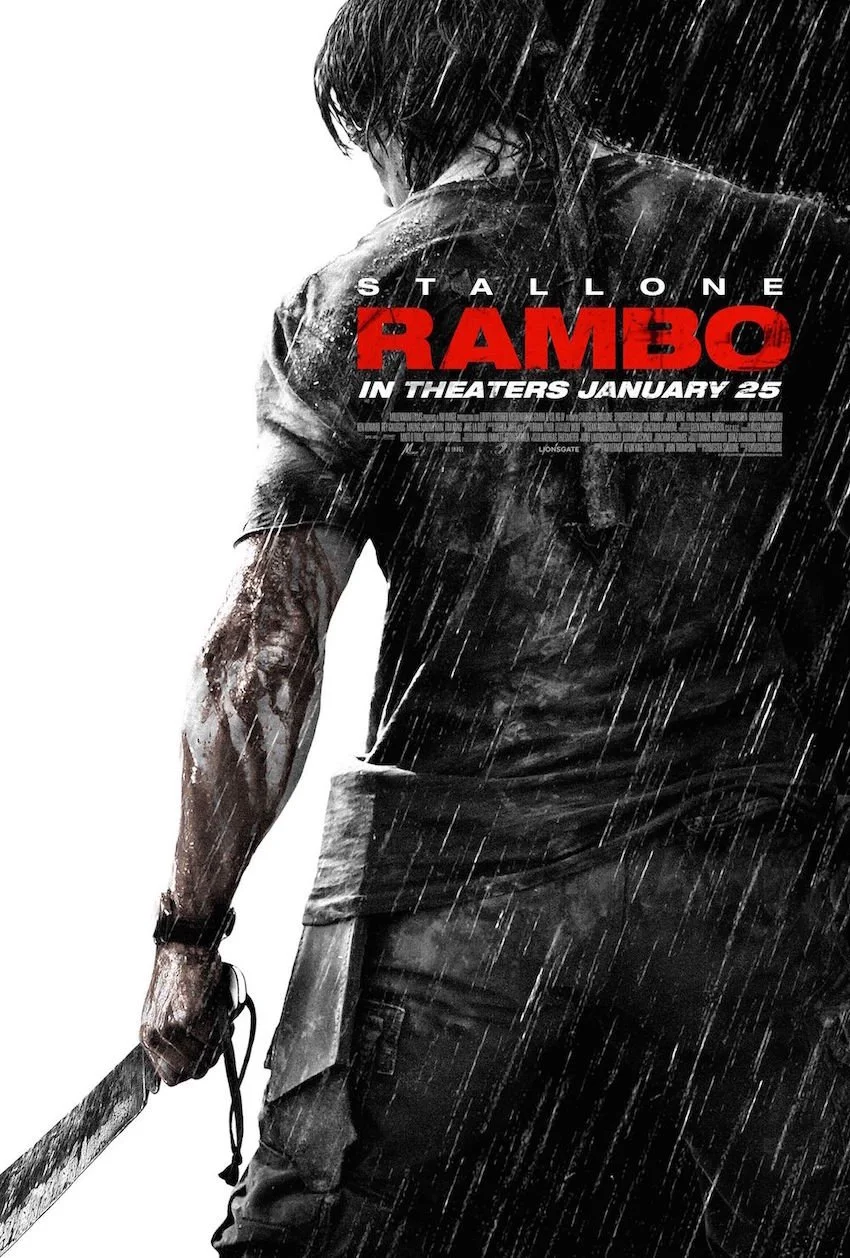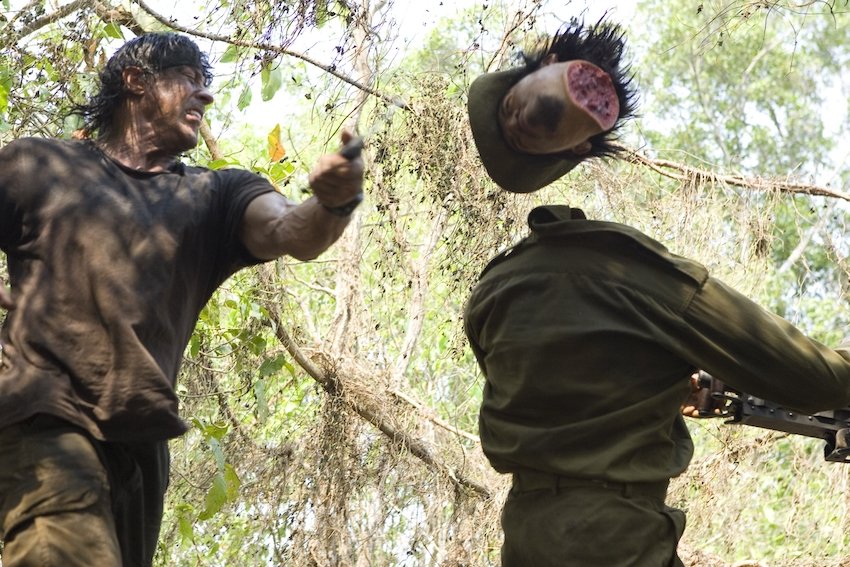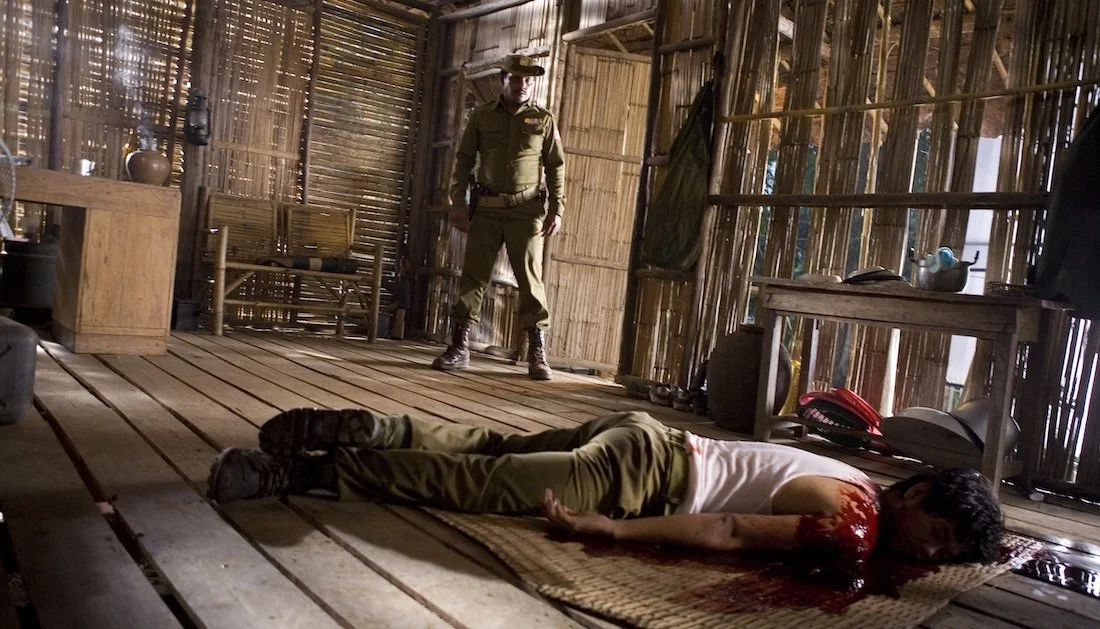Fourths Of July: RAMBO (2008)
2008’s RAMBO, the fourth installment in Sylvester Stallone’s iconic action franchise, changed the game in depictions of violence in action movies and the franchise’s pre-established approach. It was the first R-rated movie I remember seeing in theaters and still puts the R in R-rated years later. The film follows the titular traumatized Vietnam War veteran (Sylvester Stallone) as he rescues missionaries and gets into the conflict between the Burmese army and Karen rebels. It’s the rescue mission plot the previous two sequels used, but it’s still simple enough to work here as well. It’s great to see how a franchise, over a quarter of a century old in this period, still finds ways to stay fresh in an appropriately brutal fashion.
Case in point, everything in this installment becomes far more tonally aggressive than before. The cinematography, plot, and Stallone’s performance are intensified to an extreme degree.
If one watched the first three entries in a row before watching this one, they wouldn’t be expecting a gruesome shot of a missionary getting his legs blown off. It’s just so jarringly fascinating, but it shows the influence of other ‘00s genre films.
RAMBO was a part of a sea of films in that decade going hard into the darker and realistic trend. This was certainly also amplified by the success of distributor Lionsgate’s flagship horror series Saw. Considering another Lionsgate action movie released later in the same year, PUNISHER: WAR ZONE (2008), also upped the gore, there might be a connection there. Perhaps Lionsgate felt they could translate the success of the Saw films into their action films.
On that front, RAMBO definitely succeeds and absolutely indulges in flooding the screen with carnage candy.
The increased violence really is the film’s main draw alongside Stallone returning to the role. Arms, legs and even throats are not safe from Rambo’s wrath this time. It’s actually incredible the large body count didn’t warrant an NC-17 rating from the MPA. The film’s pinnacle of absurdly over the top violence is undoubtedly the final battle between Rambo and the Burmese army. You know you’re about to see some insanity when Rambo infamously wields a .50 caliber gun, reducing soldiers to salsa. Adding to that is how virtually every living character the film introduces also fights together with Rambo. These visuals have defined the franchise for today’s generation in how unrelenting they are.
Contrasting with the action sequences in RAMBO: FIRST BLOOD PART 2 (1985), the spectacle there was in the extravagant explosions and intense sound design. Here, it’s really in the extensive gore, reflecting the changing sensibilities in action film presentation by the ‘00s. The kinds of thrills in the former film had already been endlessly done by other action films through then. Stallone clearly recognized he needed to switch things up in this film, especially since it was the franchise’s fourth (and expected at the time to be the last) installment.
Credit is due for Stallone’s filmmaking abilities as it was an inspired decision to shoot the movie in a grimy and muggy manner, making one feel uncomfortable from the film’s start.
Not to mention the constant shaky cam and quick cutting between shots, which normally can make action scenes incomprehensible, but work here in making the action sequences seem more nerve-wracking.
It all makes the bloodshed hit ten times harder. Ironically, the title character isn’t quite at the carnage’s center as one would assume he would be this time around.
The movie’s bloody reputation doesn’t only come from the exploits of Rambo himself, but rather from the gruesome actions of the main villain, Major Pa Tee Tint (Maung Maung Khin) and the Burmese army. Tint gets so much screen time and characterization that he can qualify as a co-lead alongside Rambo. In the previous two Rambo films, the villains were stereotypical Russians that did basic action movie villain things. Tint and his army’s actions in this film are so excessive it’s almost cartoonish between them killing women and children and burning villages down. Tint is even in a shot where village fires reflect in his sunglasses to let the audience know he’s the villain.
One interesting aspect about their depiction is that Tint, in particular, is played by an actual Karen rebel named Maung Maung Khin and his character’s cruelty is meant to be depicted as true to real life Burmese soldiers as possible. This attempt at realistic characterization is another indicator of the theme the film conveys.
There are many moments where the violence makes a point about the meaninglessness of it. Unlike the other Rambo films opening with sequences highlighting Rambo’s characterization, this starts with a graphic scene focusing on the horrors faced by the Burmese people at Tint’s hands. Besides the opening, the rest of the film consistently moves between being a straightforward action film and a commentary on the tragedy of war. This juxtaposition is somewhat self-defeating for the film’s message, but it feels right at home considering how many past action films have attempted similar connections between violence and a message.
The Rambo films are no stranger to these kinds of anti-combat themes, but this installment is the strongest the franchise has leaned towards them since the original FIRST BLOOD (1982). The violence here, besides obvious entertainment value, serves to drive this message home. It makes sense since like Stallone’s other character comeback film, ROCKY BALBOA (2006), the film was clearly trying to hearken back to the original film’s gritty mood.
Looking back after watching it in theaters back in 2008, RAMBO still holds up as a messily entertaining last stand for Stallone’s famous action hero. This movie was just so awesome as a routine but enjoyable conclusion that it makes the similarly violent RAMBO: LAST BLOOD (2019) very unnecessary. Even after that movie was released, the violence here still packs a punch because of how the movie itself is deeply in love with depicting it as often and as detailed as possible. When it comes to famous fourth franchise installments, RAMBO is one of the wildest out there.





